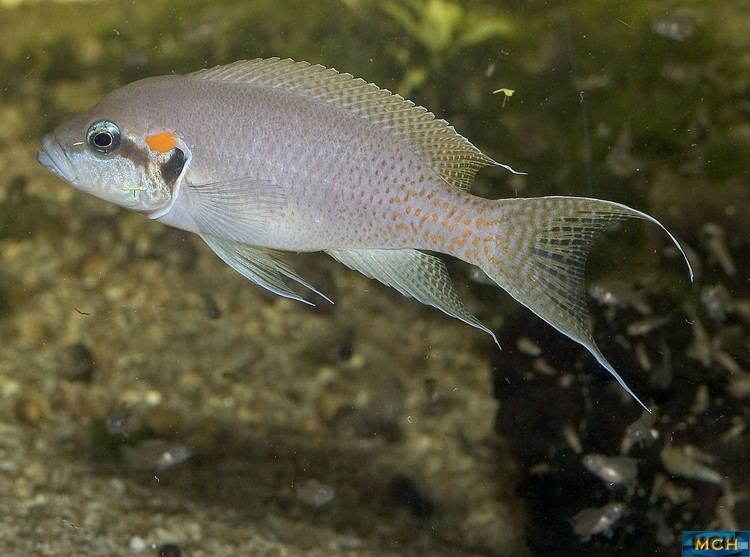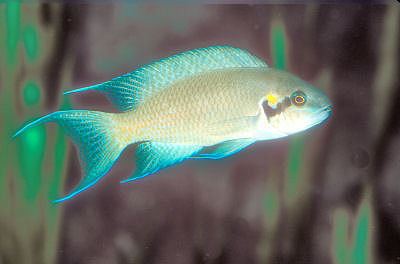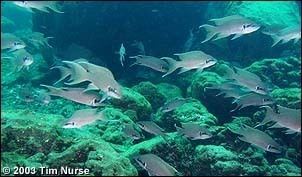Subfamily Pseudocrenilabrinae Genus Neolamprologus Phylum Chordata Rank Species | Tribe Lamprologini Scientific name Neolamprologus brichardi Higher classification Neolamprologus Order Perciformes | |
Similar Neolamprologus, Cichlid, Neolamprologus leleupi, Lamprologus, Julidochromis | ||
Neolamprologus brichardi cichlid with fry
Neolamprologus brichardi is a species of cichlid endemic to the alkaline waters of Lake Tanganyika in east Africa. It is a popular aquarium fish kept in the fishkeeping hobby, where it is known under a variety of common names including Princess cichlid, Princess of Burundi, Lyretail cichlid, Fairy cichlid and Brichard's Lamprologus. In addition, the species is also the subject of numerous studies on fish behaviour.
Contents

N. brichardi is notable in a number of ways. This fish is a substrate spawner (lays eggs on substrate), utilizing the rocky rubble to do so. It is one of the few substrate-spawning cichlid that also schools. It is not unheard of to find a school numbering near 100,000 individuals within a 50 m square area. It is one of the few fish in Africa that utilizes a collective nursery. This means that adults, sub-adults, and even half-grown fry all participate in a multi-generational rearing of the fry. N. brichardi individuals not only care for their own fry but also the fry of those around them, all while keeping vigil over other adults still actively spawning. This is similar to the cooperative breeding system of a related species of cichlid, Neolamprologus pulcher, in that N. pulcher individuals will care for the offspring of others.

N. brichardi specializes on feeding from the rocky biocover, picking at small crustaceans and invertebrates. It will also feed on swarms of plankton when available.

In the aquarium, specimens of brichardi have been known to grow to 150 mm (6"), including the filaments on the tail. This is one of the easiest Tanganyikans to keep, and indeed to breed, and a true beginner's fish. The fish will begin to breed in the aquarium as early as 5 cm (2"). They aren’t particularly choosy in selecting spawning mediums, and are known to spawn in rockwork, conch and welch shells, and inverted flower pots. As in the wild, the parents will allow many generations of fry to stay within the territory, and indeed these fry will assist the parents in guarding the younger fry.

A very important item to consider in selecting brichardi for an aquarium is to be mindful of how protective this fish is in defending its fry. They have been known to have spawns numbering more than 100 fry at a time. It is not at all unheard of for a single pair of brichardi to take over a mixed tank of Tanganyikans, even as large as a 120 cm (4 ft), 75-gallon aquarium. As they tend to pair off earlier than most other Tanganyikans, this becomes quite a common occurrence, with all of the other fish either huddled in the top corner, with some degree of damage, and often dead. They breed prolifically in optimal tank conditions but as the fry increase in number after many months they have been known to eat young fry to make room for more.

The best method for keeping Neolamprologus brichardi is in a species-only tank. A tank as small as 15 gallons can be utilized, though between 20 and 35 gallons would be more appropriate. By keeping this fish on its own, not only do you limit the chance they will eliminate their tankmates, but their graceful finnage will likely grow better.

That is not to say that it is impossible to keep this fish with other Tanganyikans, but one must be careful in selecting tankmates, and the aquarium should be at least 90 cm long (36"), with a 120 cm (48") tank being preferable. Some commonly available fish that should be compatible would include: Neolamprologus leleupi, cylindricus; Altolamprologus calvus, compressiceps; Julidochromis marlieri or regani.
There is, however, a bit of a secret to making this work. Any other tankmates must be much larger than the brichardi to begin with and they must establish their territory in the aquarium first. Purchasing an adult pair of calvus and juvenile brichardi would be an example of a situation that would normally work out. There is one important caveat: in a tank of less than 120 cm (48") you would be limited to two pairs of fish when including brichardi in the mix, though this may not even be successful.
Keeping N. brichardi with Malawian or Victorian cichlids or with Tanganyikan shell dwellers can cause problems. In a 180 cm (6 ft) aquarium it may be possible to house N. brichardi with many fish that you would not otherwise be able to do. Even in a large tank it is not very easy to pull off, and you must know how to build territories that will limit where certain species of fish will go.
In the aquarium, this fish will readily accept prepared foods, such as cichlid pellets, and flake food, but it is recommended to supplement this diet with brine shrimp, mysis shrimp or Cyclops.
